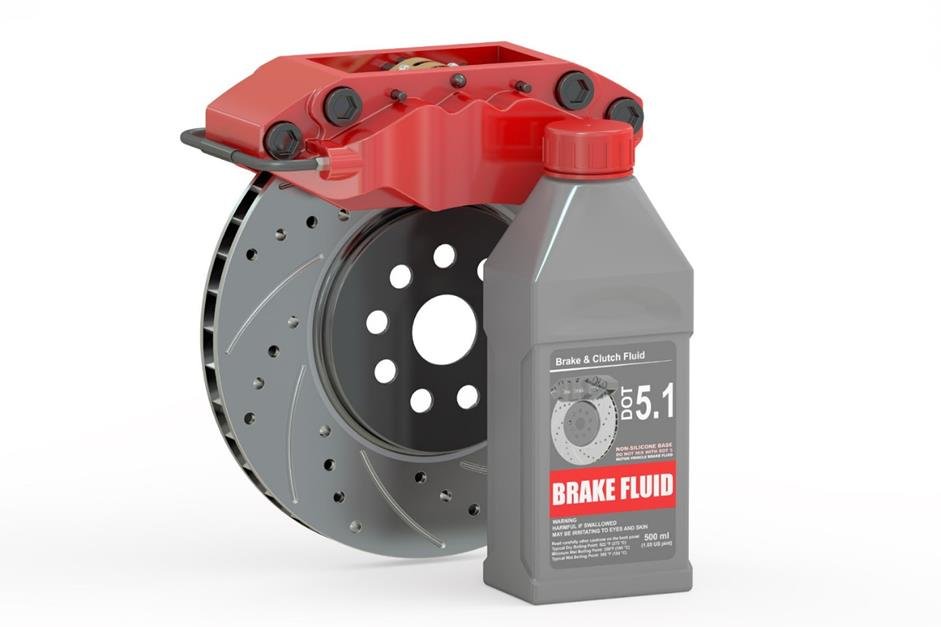Brake fluid is an essential component of a vehicle’s braking system since it plays a critical role in ensuring the safety of drivers and passengers. This type of vehicle technical fluid is quite a long-lasting consumable. It’s precisely because of this property that many drivers don’t pay attention to it so often. This can be a mistake, because it needs to be replaced at least once every two years. At the same time, you need to choose the right fluid that will meet specific requirements when changing it. Here’s everything (and more) you need to know about this consumable.

Table of Contents
The Fundamentals About Brake Fluid
Brake fluid is a hydraulic fluid that transmits the force created by your foot on the brake pedal to the brake calipers or drums, which then apply pressure on the wheels to slow or stop the vehicle. This consumable also lubricates the brake components it contacts, reducing wear and extending the brakes’ service life. The majority of modern brake fluids are petroleum-based, with the most common types being DOT 3, DOT 4, and DOT 5.1.
One thing to keep in mind is that brake fluid is hygroscopic, meaning that it absorbs water from the air over time. This is a problem because water can reduce the structure and boiling point of the fluid, which can lead to brake fade or failure, especially during rapid braking or long descents. Exposure to water can also cause the corrosion of metal brake parts, leading to more serious issues and breaks. As a result, it’s a good idea to replace your brake fluid every 2-3 years, depending on the manufacturer’s recommendations.
Speaking of the chemical composition, brake fluid can have three variants of origin that depend on its main element:
- silicone;
- glycol;
- mineral
The rest of the components are impurities that affect the behavior of the liquid under certain conditions. For example, rake fluid must also have inhibitors in its composition that resist corrosion, not only of ferrous metals but also of non-ferrous metals such as aluminum and alloys based on it, copper, brass, and others.
How to Choose Proper and High-Quality Brake Fluid

When it comes to selecting brake fluid, it’s essential to know which type is recommended specifically for your vehicle. For example, DOT 3 and DOT 4 brake fluids are the most common and are interchangeable in most applications, but always check your owner’s manual to confirm. At the same time, DOT 5.1 brake fluid is more advanced and has a higher boiling point than DOT 3 and DOT 4, making it ideal for high-performance vehicles or heavy-duty applications.
It’s worth noting that the use of the liquids mentioned above on cars older than 15–20 years is extremely dangerous. After all, the rubber elements produced before them were simply not designed for such a chemical composition and could break down during operation. This is why we recommend using mineral-based brake fluids for older cars.
As of today, the most advanced brake fluid is a silicone compound labeled DOT 5. They don’t absorb moisture, don’t freeze, and can work perfectly at a temperature of +572 °F (around +300 °C). At the same time, you need to remember that DOT 5 and DOT 5.1 fluids cannot be mixed. This can cause delamination and loss of fluid properties, as well as clogging of the brake system.
Thirdly, it’s vital to use quality brake fluid and avoid cheap, unknown-brand fluids. Low-quality brake fluids may not meet the necessary specifications and can lead to poor brake performance or even dangerous brake failure. Reputable brands such as Brembo, Motul, and Castrol produce high-quality brake fluids that are designed to handle the high temperatures and pressures of modern braking systems.
When to Change Brake Fluid
We already know that brake fluid can become saturated with moisture in any case. Because of this, its use is limited. However, it depends on the composition of the liquid. For example, mineral liquids practically don’t absorb moisture, so they retain their properties for at least 5-7 years. Note that they aren’t suitable for all cars. Experts recommend replacing such fluids once every two to three years or under emergency conditions.

Glycolic fluids (DOT 3 and 4) absorb moisture much faster, although they are considered more effective when a car brakes. Therefore, they need to be replaced more often—on average, once every two years.
Silicone fluids should be replaced on average once every 10 years. It should be remembered that DOT 5 and DOT 5.1 fluids are prohibited for use in braking systems equipped with an automatic anti-lock braking system (ABS).
The Bottom Line
Brake fluid is a vital component in ensuring proper brake performance and safety. Regular brake fluid changes and the use of quality fluids can help prevent costly brake repairs and even accidents. By understanding the basics of brake fluid, you can make informed decisions when it comes to maintenance and repairs, ensuring your vehicle stays safe and roadworthy.





